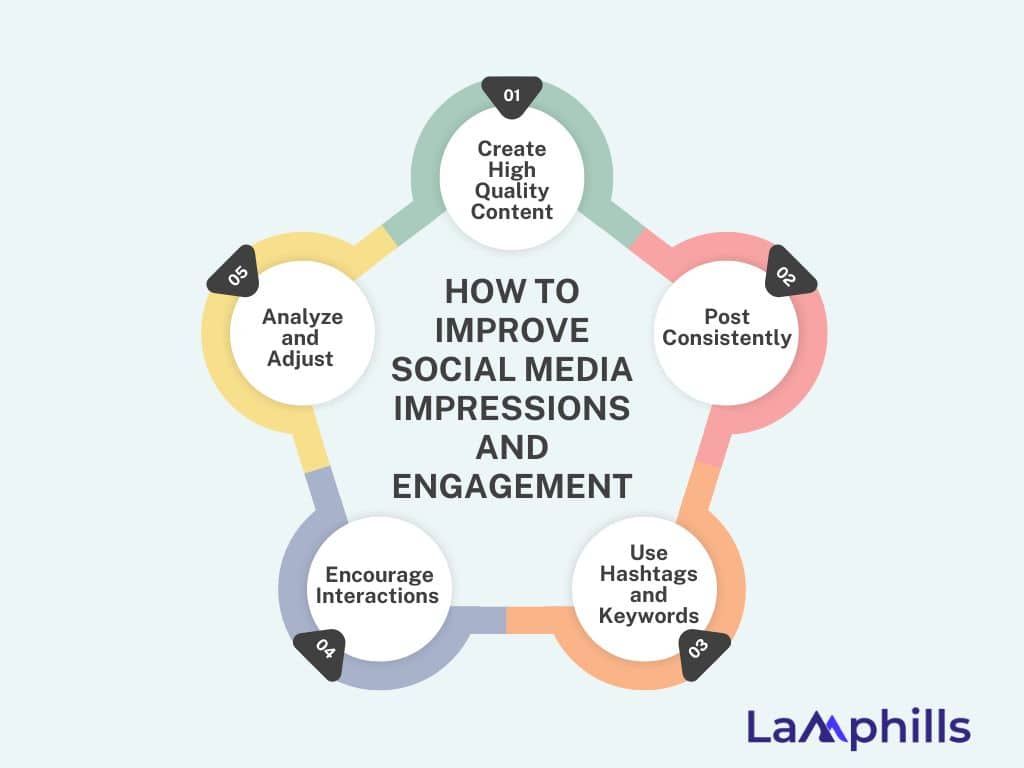If you’re managing a social media campaign, you’ve probably come across the term social media impressions. But what exactly is impressions, how do you calculate it and why should you care? Simply put, impressions tell you how often your content is displayed on a platform. Impressions provide insight into your brand’s visibility and can be a key indicator of your campaign’s reach, therefore, you must understand how it works and how to improve it. In this guide, we’ll break down everything you need to know about calculating social media impressions, why they’re important, and how to ensure you’re getting the most out of this essential metric.
Key Points
- Impressions are a great way to gauge how often your content is circulated on a platform. It counts the number of times your content—a post, story, or ad—is displayed on someone’s screen.
- A 2023 Hootsuite report highlights that brands with higher impressions mostly have better brand recall.
- You can calculate or measure your social media impressions using the analytics provided by the platform.
- While impressions are important, they’re just one piece of the puzzle. To get a complete picture of your social media performance, you should also pay attention to metrics like reach, conversion rate, click-through rate, views, and so on.
What Are Social Media Impressions?
First things first, let’s define what social media impressions actually are. Impressions count the number of times your content—a post, story, or ad—is displayed on someone’s screen. Whether someone scrolls past it, looks at it for a second, or clicks through, each display counts as an impression. Impressions can be either of the following:
Organic Impressions: These occur when your content is shown to users without any paid promotion.
Paid Impressions: These are generated through paid advertising efforts and can be tracked separately from organic impressions.
Understanding Impressions
Impressions are a great way to gauge how often your content is circulated on a platform. Unlike reach, which counts the number of unique users who see your content, impressions tally up every instance your content is shown, even if the same person sees it multiple times.
For example, if your Instagram post shows up in a user’s feed five times, that’s five impressions, even if it’s the same person each time. Impressions are all about visibility; they tell you how frequently your content is being seen, which helps you understand your brand’s exposure.
Why Social Media Impressions Matter
When I first started in digital marketing, I didn’t fully appreciate the importance of impressions. It wasn’t until I worked on a campaign for a small business that I realized how impressions contribute to brand visibility. Impressions are a key metric for understanding how frequently your content appears. They give you an idea of how your content is being seen, which can directly impact your brand’s visibility.
A 2023 Hootsuite report highlights that brands with higher impressions mostly have better brand recall. The more frequently your content appears in users’ feeds, the more they remember your brand.
Remember Simone Biles, who will never be forgotten soon because of her extraordinary performance and achievement during the 2024 Olympics in Paris. It just kept popping up each time on each social media platform.
How to Calculate Social Media Impressions on Different Platforms
Over the years, I’ve become adept at tracking impressions on various platforms. Below is how I calculate my impressions on some of the most popular social media sites:
#1. Facebook
Go to Facebook Insights, where you’ll find a detailed breakdown of your content’s performance. Under the “Overview” section, you’ll see a metric for “impressions” that tells you how many times your content has been displayed.
How to Calculate Social Media Impressions on Facebook
Facebook does the heavy lifting for you. Simply check the insights for your posts or ads to see how many impressions they’ve racked up.
#2. Instagram
If you have a business account, head over to Instagram Insights. Under Insight, swipe up posts or stories to see the “impressions” metric.
How to Calculate Social Media Impressions on Instagram
Like Facebook, Instagram tracks impressions automatically. This means you can easily monitor how many times your content is viewed.
#3. X (Twitter)
The X (Twitter) Analytics is your go-to tool here. Under the “Tweets” tab, you’ll find a detailed view of impressions for each tweet.
How to Calculate Social Media Impressions on X
X provides the number of impressions in your analytics, giving you a clear view of how often each tweet is displayed.
#4. LinkedIn
LinkedIn, the world’s most popular professional platform, also has its way of monitoring or calculating impressions. Access LinkedIn’s Page Analytics and check the “Updates” section for impressions.
How to Calculate Social Media Impressions on LinkedIn
LinkedIn shows impressions for each post in the “Updates” section, helping you understand how often your content reach users.
How to Calculate Impressions: Other Metrics to Consider
While impressions are important, they’re just one piece of the puzzle. To get a complete picture of your social media performance, you should also pay attention to the following metrics:
#1. Engagement Rate
This measures how people interact with your content (likes, comments, shares) relative to the number of impressions. A high engagement rate paired with high impressions suggests your content resonate with your audience.
#2. Conversion Rate
This shows how many people took a desired action (purchasing or signing up for a newsletter) after seeing your content. It’s the ultimate measure of your content’s effectiveness.
#3. Click-Through Rate (CTR)
CTR indicates how many people clicked on a link in your post compared to the number of impressions. It’s a key metric for assessing how effective your content is at driving traffic.
#4. Reach
This metric tells you how many unique users have seen your content. Comparing reach with impressions helps you understand how often your content is being viewed by the same users.
Lamphills’ Social Media Analytics Checklist
This comprehensive checklist guides you through the essential metrics to track, including impressions, reach, engagement rate, CTR, and conversions.
Download Lamphills’ Social Media Analytics Checklist
Best Practices for Maximizing Social Media Impressions
Now that you know how to track and calculate social media impressions, let’s see how to maximize them. The following are some best practices to keep in mind:
#1. Consistency is Key
Posting regularly keeps your content in front of your audience, which can significantly increase your impressions. In fact, a 2023 Buffer report found that brands posting consistently saw a 27% higher impression rate than those with irregular posting schedules.
#2. Tailor Content to Each Platform
Different platforms have different algorithms. So, optimize your content for each one. For instance, Instagram’s algorithm favors visually appealing content, while Twitter’s focuses more on timely updates.
#3. Use Hashtags Wisely
On platforms like Instagram and Twitter, hashtags can extend the reach of your content, leading to more impressions. According to HubSpot, posts with at least one hashtag see 12.6% more engagement, which can also boost impressions.
#4. Consider Paid Advertising
Sponsored posts and ads are an effective way to increase your impressions. Platforms like Facebook and Instagram offer advanced targeting options, ensuring your content is seen by a larger, more relevant audience.
Read Also: Earned Media Value Explained: Why It Matters and How to Calculate It
Common Pitfalls to Avoid
While it’s important to focus on increasing your impressions, there are a few pitfalls to watch out for:
#1. Overemphasizing Impressions
Recording high impressions is great; however, this doesn’t tell the whole story. Your primary focus shouldn’t be impressions without considering other metrics like reach, engagement, CTR, and conversion rates. All these give you a full understanding of your content’s effectiveness.
#2. Misinterpreting Data
Don’t let high impressions fool you into thinking your content is performing well. If you’re seeing a lot of impressions but not much engagement, it might be time to rethink your content strategy.
What Are Examples of Media Impressions?
The following are some examples that illustrate how impressions work:
- Display Ads: Every page load with an ad counts as an impression.
- Social Media Posts: Each appearance in a user’s feed counts as an impression.
- TV Commercials: Every viewer counts as an impression.
- Billboard Ads: Each drive-by counts as an impression.
- Print Media: Every read copy counts towards ad impressions.
What Best Describes Social Media Impressions?
Social media impressions represent the total number of times your content is displayed on a user’s screen. Unlike reach, which measures the number of unique users who see your content, impressions count every instance of content being shown.
Do Views Count as Impressions?
Absolutely, views are considered impressions. Impressions count every time content is shown, so if a user watches a video multiple times, each view counts towards the impression total. However, views reflect the number of distinct users who have seen the content.
How Do You Determine Social Media Impressions?
Over the years, I have used the following to determine my social media impressions:
- Platform analytics
- Analyzing and comparing
- Optimizing your strategy
Social Media Impressions vs. Engagement
Impressions represent the number of times your content—be it a post, story, or ad—appears on a screen. Engagement, on the other hand, goes beyond visibility. It measures how people interact with your content. This includes actions like; likes, comments, shares, clicks, saves, and retweets.
Engagement is a more active metric—it shows that your audience sees and interacts with your content. High engagement rates generally indicate that your content resonates with your audience, encouraging them to take action.
Impressions vs. Engagement: Key Differences
The table below outlines the key differences between impressions and engagement.
| Terms | Impressions | Engagement |
| Purpose | Impressions focus on how often content is shown. | Engagement measures how people interact with that content. |
| Measurement | Impressions count every time a piece of content is displayed. | Engagement tallies up interactions like likes, shares, comments, and clicks. |
| Impact on Brand Awareness | Impressions help build brand awareness by increasing the frequency with which your content is seen. | Engagement drives deeper connections with your audience, fostering loyalty and trust. |
| Evaluation of Content Success | High impressions with low engagement might suggest your content is not resonating with your audience. | High engagement with lower impressions can indicate the content is highly relevant to a smaller, more targeted audience. |
Why Both Metrics Matter
A successful social media strategy often involves balancing these two metrics. High impressions help you reach a broad audience, while high engagement ensures the message is compelling and relevant to those who see it.
How to Improve Impressions and Engagement

I’ve used the hacks below to improve impressions and engagement. I believe they’ll be handy for you too.
#1. Create High-Quality Content
The key to impressions and engagement is content that resonates with your audience. Ensure your posts are visually appealing, informative, and tailored to your audience’s interests.
#2. Post Consistently
Regular posting helps increase impressions by keeping your content in front of your audience. Consistency also builds familiarity and trust, which can boost engagement.
#3. Use Hashtags and Keywords
On platforms like Instagram and Twitter, hashtags and keywords can extend the reach of your content, leading to more impressions. The right hashtags can also drive engagement by connecting your content with interested users.
#4. Encourage Interaction
Ask questions, run polls, and use call-to-actions (CTAs) to invite your audience to interact with your posts. This boosts engagement and also increases the chances of your content being shared, leading to more impressions.
#5. Analyze and Adjust
Regularly review your social media analytics to understand what’s working and what isn’t. If a post has high impressions but low engagement, consider tweaking your content strategy to better connect with your audience.
Conclusion
Social media impressions are more than just a metric—they’re a key indicator of how often your content is being seen and how effectively it’s being distributed. Knowing how to calculate your impressions helps you gain valuable insights into your brand’s visibility and make informed decisions about your social media strategy. However, don’t forget that impressions should be analyzed in the context of other metrics like reach, engagement, and conversions. This will help you get a true picture of your social media performance.
Related Articles
- Top Social Media Advertising Metrics Every Marketer Should Track in 2024
- Impressions Vs Reach In Different Channels Explained!
- How to Use Snapchat Ads Manager: Tips and Best Practices
- A Beginner’s Guide to How Pinterest Works in 2024






